Best Way To Grow Rosemary – An International Herb
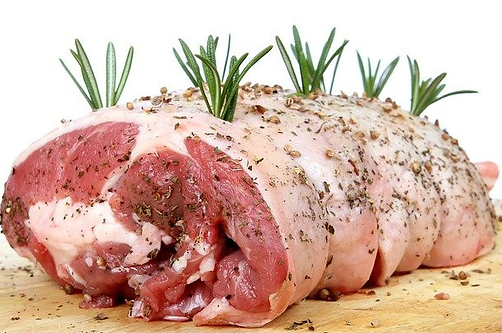
Whenever I think of rosemary I think of my mom’s special pork loin recipe. She had a knack for making the best roast pork on a rotisserie. I can still smell the aroma of the pork wafting from the open charcoal grill during the course of the day. I couldn’t wait until dinnertime! Now that I am the one cooking for the family, I try to replicate her recipes. One way I am able to do this is by growing rosemary. Read on to learn the best way to grow rosemary in your garden and to discover the other amazing uses for this international herb.
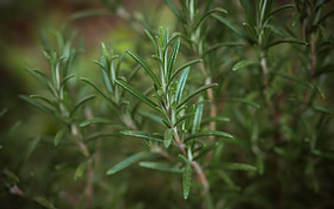
(Some of the links within this post are affiliate links on which I receive a small compensation from the sale of certain items with no extra charge to you.)
(As an Amazon Associate I earn from qualifying purchases.)
How to Grow Rosemary in the Garden
Rosemary comes from the shores of the Mediterranean Sea and is a perennial in USDA zones 8 and warmer. Although, I live in zones 6a to 7a, my rosemary has survived the last couple of winters outside in a pot. There are a few ways to grow rosemary, either by cuttings or by purchasing plants from nurseries. It is very difficult to propagate from seed and takes an extremely long time. Therefore I am not recommending that you sow your own rosemary seeds.
I suggest you either buy the plant or take cuttings from other plants.
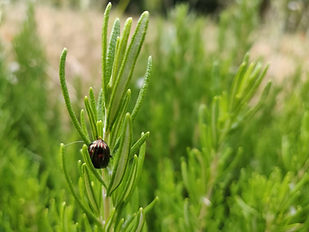
Plant in the Outside Garden
Some varieties of rosemary can spread to a bush-like size of 4 feet high by 4 feet wide. So, give some thought to where you’d like your rosemary plant. You do not want to have to transplant it once it reaches its mature size.
Choose a location that receives 6 to 8 hours of direct sunlight with good, well-drained soil. The soil should be equal amounts of organic and sandy soil. Rosemary does not like a soggy, moist environment, therefore you may have to add some filtered sand to the ground.
Water the plant well when planting it in the ground and then 2 to 3 times per week during the summer, especially if you live in a very hot environment.
Once the top inch of the soil is dry, give it a watering.
Propagating Rosemary for Outside or Container Planting
Cuttings in Water
It is very easy to propagate rosemary from cuttings.
Once the mother plant has grown around 10 inches high, clip a 5 to 6 inch stem from the new growth on top. Clip about 3 to 4 stems in case they do not all form roots.
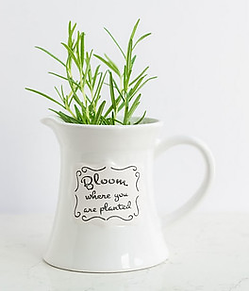
Choose stems with new growth and that are green and flexible, but not woody.
Using your fingers, gently scrape the bottom 2 inches of leaves from the stem.
Place them in a clear jar, covering the bottom inch with water. Change the water every 2 days with room temperature water so no bacteria forms and the roots do not rot.a
You should see roots forming in a week or so. Throw out any stem that has browned out and did not form roots.
Once you see 4 to 5 one inch long roots on a stem (approximately 4 to 8 weeks of growth), gently place them in a 4 inch pot with good potting soil amended with sand. Insert a pencil into the soil about 2 inches deep. Then carefully place one stem with the roots into the soil. Gently pat the soil around the base of the plant. One stem per pot.
Water the same as above.
Cuttings in Soil
Follow the above directions for propagating cuttings in water. However, once you have removed the leaves, place about 1/2 inch of the stripped stem into the potting soil/sandy soil mixture. Be sure the stem has 1 to 2 nodes submerged into the soil. (The nodes are the places from where the leaves were removed.)
Sprinkle lightly with a spray bottle one time per day for two weeks. After two weeks, water once every two days. As a rule of thumb, the older the plant, the less you water it.
When you propagate rosemary in water or soil, place the containers in indirect sunlight with temperatures hovering around 70 degrees F; 21 degrees C.
Follow the above directions for transplanting into a 4 inch pot.
Plants can grow up to 3 feet in a container. Keep transplanting the plant to a larger pot once the plant’s roots fill the pot.
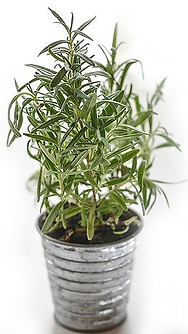
Bringing Rosemary Inside for the Winter
Once the plants have taken hold in small pots, either plant them outside after the last frost date or in a container. If you plant your rosemary in a container it is quite easy to bring it inside for the winter.
Quarantine your plant for a couple of weeks once you bring it inside. You do not want to spread any disease or infest any other indoor plants with unwanted insects that latched onto your rosemary plant.
Place the rosemary plant in a southern facing window in the northern hemisphere (northern facing if in the southern hemisphere) in order to have about 6 to 8 hours of direct sunlight.
It will thrive in temperatures from 60 to 65 degrees F (15 to 18 degrees C).
Do not place it near a heat source or any drafts.
Rosemary likes humidity, so provide it with a natural humidity source by placing the pot in a dish of pebbles filled with water. The evaporation of water will provide humidity for the plant.
Keep the plant evenly moist. Water the container when the top is dry and allow for the excess water to drain from the pot.
Common Pests of Rosemary in the Winter – Troubleshooting
Rosemary plants are susceptible to aphids, whiteflies, and spider mites. They will suck liquid from the leaves and cause the plant to dry up. Treat the insects with insecticidal soap. (Available at Amazon)
If you water the plant too much, you will see signs of mold, powdery mildew and root rot. Wait until the top one inch of the soil is dry before watering the plant.
Mold, mildew and root rot can also be caused by poor air circulation. Place a fan near the plants to circulate the air. Do not place the fan where the breeze will directly contact the plant.
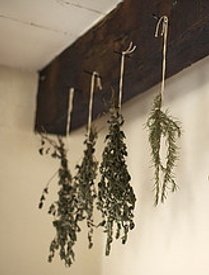
Harvesting Rosemary
Harvest up to a third of your rosemary plant at a time. You want to be sure the plant produces more stems. When you cut a stem, two more stems will shoot out from that spot. You can guide your plant’s growth by deciding from where to cut the stems.
It is quite simple to harvest rosemary. Clip the new growth (top 5 to 6 inches) of the plant and use it fresh in your favorite culinary dishes. Or hang the stems upside-down in the kitchen to dry out. Wrap the bottom of the stems with twine but not too tightly. You want air to circulate through the stems to aid the drying process.
Once the stems have dried, you can either strip the leaves from the stems or place the full stem into air tight containers.
Store in a cool, dark location. For optimal flavor, you can store the rosemary up to 12 months.
Uses of Rosemary
Rosemary is useful for improving digestion. You can add this tasty herb to many of your favorite dishes.
Culinary Delights
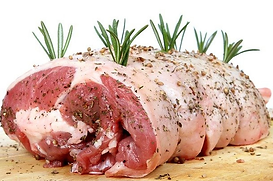
Marinated Roast Pork Loin
Ingredients:
-
1 1/2 to 2 pounds pork loin
-
1 to 2 heaping tbsp of fresh rosemary (2 to 3 tsp of dried rosemary)
-
1 to 2 heaping tsp of dried paprika
-
1 heaping tsp of ground pepper
-
1 heaping tsp of salt
-
2 heaping tbsp of minced garlic
Directions:
You can either roast this in the oven or put it on a rotisserie on the grill.
-
Remove the pork loin from the package and wipe dry with a paper towel
-
Place the pork on a flat surface and with a sharp knife, dig and turn the knife into the pork loin to create a quarter inch hole. Continue doing this every inch and a half throughout the entire loin (top, bottom and sides)
-
Place a few pieces of minced garlic into each hole
-
Generously shake dry herbs over the loin and press down
-
Wrap tightly with saran wrap and place in the refrigerator to marinate at least 5 hours; overnight is better
-
If baking in an oven, place in a shallow pan and bake at 350 degrees F for approximately 40 minutes or until internal temperature is 145 degrees F; if roasting on a spit over a charcoal fire or gas grill, cook for approximately 45 minutes or until internal temperature is 145 degrees F; place a drip pan under the spit and baste with drippings; you do not want to overcook the pork

As an alternative, you can butterfly the pork loin and rub the inside of the pork with a paste created by combining the ingredients above in addition to adding the herbs to the outside. After doing this, place the two sides together and truss the pork every one and half inches. You will also need to double the amount of herbs and garlic to create the paste.
Rosemary is also used to flavor oils, salad dressings, butters and breads.
You can also brew it in a cup of tea.
Brewing Tea
Ingredients:
-
1 tsp loose rosemary leaves
-
10 ounces of boiled water
Directions:
-
Place rosemary leaves directly into water or into a tea infuser
-
Steep for 5 to 10 minutes
-
For added flavor, steep with lavender rosemary tea or thyme rosemary herbal tea
Medicinal Uses – Sited from Medical News Today
Rosemary is a good source of calcium, vitamin B6 and iron.
It is rich in antioxidants which neutralize free radicals.
Rosemary is said to improve indigestion but there is no scientific proof of this.
The aroma is supposed to improve a person’s concentration, mood, speed, accuracy and performance.
Some studies show it is protective against brain damage and may improve recovery from a stroke.
Preliminary studies show it may help prevent brain aging including the onset of Alzheimer’s, however more studies have to be conducted.
“A study published in the journal Investigative Ophthalmology & Visual Science, led by Dr. Stuart A. Lipton, Ph.D. and colleagues at Sanford-Burnham Medical Research Institute showed it can significantly promote eye health”. (Medical News Today)
As always, consult your physician before utilizing rosemary for any health problems or substituting it for any medications.
Below is a YouTube video showing other uses of rosemary.
Easy and Versatile Rosemary
I hope you learned a thing or two about the rosemary herb. As you can see it is not that difficult to grow. Use it for culinary dishes, medicinal reasons, or just for its beauty. It has delightful blue, white or pink flowers. Depending on the variety it will bloom in either late spring to early summer and attract bees, or late fall to early winter and can be used as decorations for the holidays.
Please leave a comment below. I’d love to hear from you!
Happy Gardening!
Nina
bestgardeningforbeginners@gmail.com

